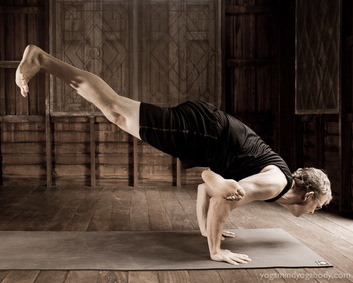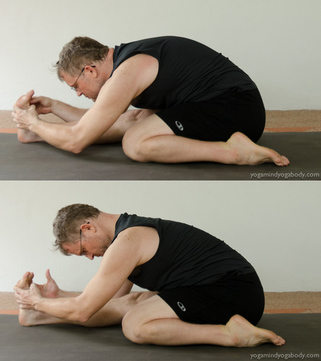|
Most of us have a tendency to work too hard in yoga at least some of the time in an effort to try to force improvement in our practice. However, over-efforting is counterproductive because it increases the likelihood of injury and thwarts our enjoyment of the present moment, which in turn impedes our ability to practice awareness with serenity. In addition, too much power in our practice makes it difficult to explore the refinements of the poses, to notice and adjust minor alignment imbalances, and to find expressiveness, spaciousness, and freedom in each pose. So how do you go about striking that balance between power and refinement? The answer is through the breath. Think of your body as an orchestra, and your breath as the conductor. Each musician—each body part—knows how to play their part, but to create a coordinated, immersive, transformative whole, the individual parts need to be coordinated, synchronized, orchestrated. The breath does this, but it does a whole lot more. Just like a conductor sets the tone of the music, the breath sets the tone of your practice. There are some fundamental rules of good breathing: the breath should always be smooth, steady, and free of strain. But there is also quite a bit of room for individual expression in the breath, and creatively varying the breath is how we can shift the balance between power and refinement in each pose, and at every stage of each pose. We do this by varying both the depth of the breath and its pulsation:
(The principles underlying this week’s theme come from Erich Schiffmann’s excellent book Yoga: The Spirit and Practice of Moving into Stillness.) Originally posted on Gernot's website
0 Comments
Dear friends,
See that little blue dot there on the left of the picture? That's me with my 7 month little Tao on my back during our recent trip in New Zealand! The wind was blowing 80 km/h and it was hard to walk straight. It was quite an adventure :-) You might wonder: "What the heck were you doing there?" Well, there were times I asked myself the same question, no doubt. To be honest, the answer today is "because it makes me feel so ALIVE". My body feels vibrantly alive. My senses are wide open. I'm speechless (apart from repeated WAWs) looking at the mountains, glaciers, lakes, clouds. (I say all of this after making sure that Tao is warm, protected and well-fed) I truly feel like I'm making the best of this life. Time is limited. I know that the end will come too soon. Before we know it, we'll be 80 with no teeth and no power in our legs and back. The time is NOW. I had to laugh hearing this quote: "Live life on the edge, otherwise you're taking up too much space." Do you feel like you're living life on the edge? Or are you always in your too cosy comfort-zone? Are fears stopping you? What would happen if you felt the fear and did it anyway? To be totally honest with you, I feel like as a yoga teacher I also dance at the edge. Our upcoming Yoga Teacher Training at Wild Rose feels like a very exciting risk. It is the first training at Wild Rose and the first one that I'm leading. I feel ready :-) As you can see, I've changed the format of my emails too. I want to share more openly what's happening in my world. It feels a bit risky too. I wish you all a beautiful and (healthy) risky day! Laurence Originally posted on Laurence's website A typical asana class winds down with forward bends and twists, because both types of poses are cooling. In other words, both categories of poses tend to support the down-regulation of the autonomic nervous system that helps ease the mind and body into the full relaxation of savasana. However, if you approach forward bending postures with the goal-oriented attitude of “gotta touch my toes no matter what”, you are unlikely to derive the benefits that forward bends were designed to bestow upon you. But if you can get away from your default “work hard, play harder” attitude while doing forward bends, you may find yourself finally understanding the power of surrender, the power of NOT doing. Of course, full surrender in any pose other than a full relaxation pose is not desirable either, because it can collapse the chest to the point of inhibiting the breath and promoting depression, and it can concentrate the force of the pose in the weakest link of the chain that is your body, and thus can increase the risk of injury. (In forward bends, by the way, that weakest link is generally the lower back, which tends to bend too far. The upper back tends to bend too far, too. This is much less likely to cause injury, but is the cause of the chest collapse with its associated negative effects.) The realization that full surrender is not the solution once again takes us back to the universal theme that yoga is about creating a greater balance between opposites.
When you understand that something you are doing is extreme and unhelpful, the tendency is strong to embrace its opposite as the obvious solution to the problem. But the opposite is usually just as problematic, while the real solution generally lies in finding a place of balance between the opposites. The problem with the true solution of creating balance is that it is very difficult (and not at ALL ego-gratifying) to find a place of balance. Nothing extreme happens at the place of balance to tell you that you have arrived. There are no world records to be set at the place of balance, no championships won, no competitors (or former selves) bested. The only thing you may find there is better health, greater serenity, and greater joy. In my experience, one of the pairs of opposites that most people have the hardest time finding balance between are effort and surrender, because our go get ’em culture so strongly reinforces and rewards extreme efforts, even in the world of yoga. This week we will use forward bends quite deliberately to learn how to balance effort with surrender to create a greater sense of balance in body and mind, learning to let go where we grip too tightly, but at the same time learning to create some effort in places where we never do; in short, making our practice smarter than our habits by moderating the patterns of effort and weakness in our bodies to create a greater sense of balance. Originally posted on Gernot's website |
Pranaya Yoga TeamLaurence Gilliot, Gernot Huber, Rosemary Bolivar and Lek Kittikunaudul share their insights and knowledge on Yoga Archives
April 2019
Categories |




 RSS Feed
RSS Feed
